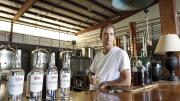The human gut microbiome—a world of bacteria that teems in your gut—profoundly affects health, but the exact mechanisms remain largely elusive. Now A. Sloan Devlin, an assistant professor at Harvard Medical School, and her team have discovered that altering a single gene in a single type of bacteria can even change the metabolism of the host organism.
Devlin focused on a specific known role of gut bacteria—the chemical transformation of bile acids, which help regulate digestion (these acids surround fats and carbohydrates, allowing humans and mice to absorb and utilize these compounds). She first identified an abundant gut bacterium that processes bile acids in a specific way, then located the gene that causes that bacterium to chemically alter these nutrients.
The goal was to isolate the exact impact of the gene’s bile-acid-altering function on its host, so she limited the number of variables by experimenting on sterile, “germ-free” mice, which host no gut bacteria, unlike either humans or mice in the wild. The team then “colonized these germ-free mice with either the normal bacterium” containing the bile-processing enzyme, or with an altered version of the bacterium, which lacked it. Both mouse populations were then “fed a high-fat, high-sugar diet,” mimicking a “Western-style human diet.”
The scientists, who published the work in eLife Magazine, could thus attribute any differences in host metabolism to the single genetic manipulation. Predictably, the mice populated with gene-deleted bacteria had more unprocessed bile acids than did mice with normal bacteria.
But other results were surprising. During the 32-day study, the mice that could not process bile, for instance, had more fat in the liver and gained weight much more slowly than the other group. They also used proportionately less fat and more carbohydrate for energy.
Devlin, a chemical biologist and molecular pharmacologist, calls that “amazing.” She has studied human gut bacteria since her postdoctoral work at UC, San Francisco with Michael A. Fischbach ’03, Ph.D. ’07 (now associate professor of bioengineering at Stanford). “It’s a bacterium,” she points out, “and a single enzyme in a bacterium, that’s causing a change in whether the host is using fats versus carbohydrates.”
Most dramatic, however, was a change observed in the correlation of lean body mass to energy expenditure. In humans and wild mice, these variables follow a linear relationship: the more lean body mass an organism has, the more energy it expends. In the mice colonized with bacteria that could not process bile acids, however, that relationship broke down. A mouse in that group with a small amount of muscle mass, for example, might expend more energy than a mouse with a large amount of muscle, even if the mice exercised the same amount. This suggests that some bacteria in an organism may control or influence physiological traits otherwise considered innate.
Devlin believes that these changes could be the result of “signaling,” a process by which physical states in the body trigger a cascade of genes to switch on or off. By starting to learn which bacteria activate specific genetic switches, researchers could take steps toward learning how to treat human conditions by altering the genetics of the gut microbiome.
Such advances could aid in treating several metabolic disorders, such as fatty liver disease, acid imbalances, and even obesity. Greater knowledge of the microbiome’s workings might also allow physicians to prescribe higher doses of life-saving drugs, potentially including cancer drugs, in treatments when dosage must be limited because the microbiome metabolizes the drugs and makes them highly toxic.
She stresses that much work remains before her research can lead to treatments. Describing her study as a “first step” of many, she underscores the need for further understanding of how humans might respond to microbiome manipulations.
Her next study will accordingly take her work “one step closer to humans.” Instead of germ-free mice, she and her team will work with “conventional” mice, whose gut microbiomes resemble ours. Instead of deleting bacterial genes, the team will chemically inhibit all bacteria from processing bile acids. Their aim is to alter mouse metabolism by manipulating the existing, native gut microbiome—and to test whether unforeseen effects of a complex microbial community might complicate the remarkable changes she achieved in the microbe-free mice.









